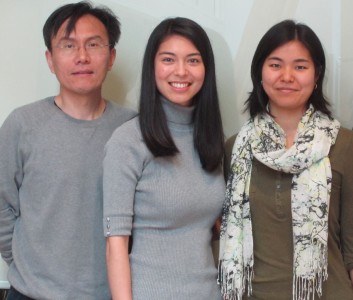Calcium is a universal second messenger important for brain and immune homeostasis, activation, proliferation, differentiation, and apoptosis. The events surrounding Ca2+ mobilization are tightly regulated and involve the coordination of diverse ion channels, membrane receptors, and signalling molecules. A calcium channel TRPV1 , has a well-recognized role in nerve cells that help regulate body temperature and alert the brain to heat and pain. It also has a role in producing the sensation of heat from red hot chilli peppers.
A new finding by UBC Centre for Blood Research scientist Wilf Jefferies and his collaborators, demonstrates that T-Lymphocytes, a type of immune cell that learns to recognize and attack microbial pathogens and cancer, are activated by the TRPV1 pain receptor. The study entitle “TRPV1 channel regulates CD4+ T cell activation and pro-inflammatory properties” was published in Nature Immunology, Bertin et al. 2014 and demonstrates that TRPV1 channels are expressed in T-lymphocytes, where they are involved in gating the influx of calcium ions required for immune activation. These results demonstrate that TRPV1 has a function outside the sensory functions of the brain. Furthermore, TRPV1 helps regulate intestinal inflammation in mammals and the data shows that the activity of TRPV1 can be manipulated, offering the potential to modify T-lymphocytes response as needed for promoting health. This research may have practical applications in improving immune responses against viral pathogens such as HIV and Ebola virus and also against tumours such as breast and prostate cancers. These findings may also lead to methods combat autoimmune diseases such as Crohn’s disease, multiple sclerosis, diabetes and arthritis.
Co-authors include Lilian L. Nohara, Hongjian Xu, Shawna R. Stanwood and Co-senior author, Professor Wilfred A. Jefferies from the University of British Columbia; Samuel Bertin, Petrus Rudolf de Jong, Jihyung Lee, Keith To, Lior Abramson, Timothy Yu, Tiffany Han, Ranim Touma, Xiangli Li, José M. González-Navajas, Scott Herdman, Maripat Corr, Hui Dong, Alessandra Franco and Co-senior author, Eyal Raz, UC San Diego; Yukari Aoki-Nonaka, UC San Diego and Niigata University Graduate School of Medical and Dental Sciences, Japan; Sonal Srikanth and Yousang Gwack, UCLA; and Guo Fu, The Scripps Research Institute.
This study was funded, in part, by Canadian Institutes of Health Research (MOP-102698), National Institutes of Health (U01 AI095623, P01 DK35108 and P30 NS047101), The Broad Foundation, Crohn’s and Colitis Foundation of America, Fulbright Association, Philippe Foundation Inc. and Japan Society for the Promotion of Science.



